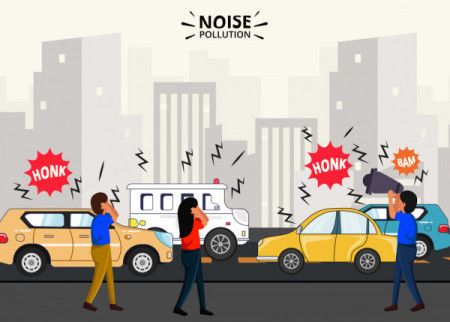Noise Pollution Definition
What is Noise Pollution?
Noise pollution refers to the presence of excessive and unwanted sound in the environment that can have harmful effects on human health and well-being. It is a growing concern in urban and industrial areas where noise levels from sources such as traffic, construction, and industrial activities can be high. Noise pollution can cause various health problems, including hearing loss, cardiovascular disease, and sleep disturbances. It can also disrupt communication and social interaction and negatively impact wildlife.

Strategies for reducing noise pollution include noise barriers, soundproofing, and regulating noise levels from industrial and transportation sources. Public education and awareness campaigns can also promote an understanding of the harmful effects of noise pollution and encourage the adoption of noise reduction measures.
Types of Noise Pollution
There are several types of noise pollution, including:
- Environmental noise: This includes noise from traffic, aircraft, trains, and construction activities. Environmental noise can significantly impact urban and suburban areas where noise levels exceed recommended limits.
- Occupational noise: This refers to noise in the workplace, such as machinery and equipment noise. Occupational noise can cause hearing loss and other health problems in workers exposed to high noise levels.
- Neighborhood noise: Neighborhood noise includes noise from loud music, barking dogs, and noisy neighbors. Neighborhood noise can disrupt sleep and cause stress and annoyance.
- Acoustic noise: Acoustic pollution refers to the cumulative effect of noise pollution over time, which can have a long-term impact on human health and well-being.
- Indoor noise: Indoor noise includes noise from appliances, HVAC systems, and home entertainment systems. Indoor noise can be a significant source of annoyance and stress.
- Natural noise: Natural noise is from natural sources such as thunder, wind, and waterfalls. While natural noise is not typically considered harmful, it can still be a source of annoyance and disturbance in certain contexts.
Causes of Noise Pollution
There are various causes of noise pollution, including:
- Transportation: Road traffic, aircraft, and railway transportation are significant sources of noise pollution in urban and suburban areas. The noise generated by these transportation modes can cause significant disturbance and annoyance.
- Industrial activities: Industrial machinery, construction equipment, and other industrial activities can produce high levels of noise pollution, which can be particularly problematic in areas where industrial activities are concentrated.
- Construction activities: Construction activities such as drilling, excavation, and building can produce significant levels of noise pollution. These activities are typically short-term but can be disruptive to nearby residents.
- Neighborhood noise: Neighborhood noise can be caused by loud music, barking dogs, and other noise sources from nearby households. This can cause annoyance and stress for nearby residents.
- Indoor noise: Appliances, HVAC systems, and home entertainment systems can cause indoor noise. While indoor noise is typically not a significant source of noise pollution, it can still be a source of annoyance and stress.
- Natural events: Natural events such as thunder, wind, and waterfalls can produce noise pollution in certain contexts, although this is typically not considered harmful.
Overall, noise pollution is a complex issue with multiple sources, and efforts to reduce noise pollution require a combination of regulations, public awareness campaigns, and technological solutions.
Effects of Noise Pollution
Noise pollution can have a range of negative effects on human health, well-being, and the environment. Some of the main effects of noise pollution include:
- Hearing loss: Exposure to high noise levels can cause hearing loss, which can be temporary or permanent, depending on the duration and intensity of exposure.
- Sleep disturbances: Noise pollution can disrupt sleep, leading to fatigue, irritability, and reduced quality of life.
- Cardiovascular disease: Prolonged exposure to high noise levels has been linked to an increased risk of cardiovascular disease, including hypertension and heart disease.
- Stress and anxiety: Noise pollution can cause stress and anxiety, reducing well-being and increasing the risk of mental health problems.
- Communication disruption: High noise levels can make communicating difficult, leading to social isolation and reduced quality of life.
- Wildlife disruption: Noise pollution can negatively impact wildlife, disrupting communication and navigation and causing stress and behavioral changes.
How to stop noise pollution?

Preventing noise pollution requires a multi-faceted approach involving individual actions, government regulations, and technological solutions. Here are some ways to prevent noise pollution:
- Reduce personal noise sources: Individuals can help prevent noise pollution by reducing noise sources, such as turning down music and avoiding loud activities in quiet areas.
- Use noise-canceling technology: Noise-cancelling headphones and other technologies can reduce exposure to environmental noise.
- Government regulations: Governments can enact regulations to limit noise pollution from transportation, industry, and other sources. These regulations can include noise level limits, noise reduction technologies, and zoning restrictions.
- Building design: Building design can reduce noise pollution by using sound insulation and other techniques to minimize noise transmission.
- Education and awareness: Education and awareness campaigns can help raise awareness about the negative effects of noise pollution and encourage individuals and communities to take action.
- Technological solutions: Technological solutions such as noise barriers, mufflers, and sound-absorbing materials can reduce noise pollution from transportation and industrial activities.
Noise Pollution Rules and Regulation
In many countries, noise pollution is regulated by laws and regulations to protect people's health and well-being. These rules and regulations vary depending on the country, but here are some common examples:
- Noise level limits: Governments can establish maximum noise level limits for different areas, such as residential, commercial, and industrial zones. For example, the World Health Organization recommends that noise levels in residential areas not exceed 55 decibels during the day and 40 decibels at night.
- Zoning restrictions: Governments can use zoning regulations to restrict noisy activities in residential areas. For example, noisy businesses may be required to locate in designated industrial areas.
- Noise reduction technologies: Some industries, such as transportation and construction, must use noise reduction technologies to minimize noise pollution.
- Noise permits: Some activities, such as outdoor concerts or construction, may require a noise permit from the local government.
- Noise complaints: Citizens can report noise complaints to the local government or police, who may investigate and take action if noise levels exceed legal limits.
Noise pollution rules and regulations are designed to protect people's health and well-being from excessive noise levels. By following these rules and regulations, we can minimize the negative impacts of noise pollution on our lives and the environment.
Measures to remove noise pollution
Eliminating noise pollution may not be possible, but there are several ways to reduce and minimize it:
- Noise barriers: Building walls and noise barriers around highways or busy roads can help reduce the noise that reaches nearby residential areas.
- Acoustic insulation: Installing soundproof windows, doors, and walls can help to reduce the amount of noise that enters a building or room.
- Traffic management: Implementing traffic management strategies such as reducing vehicle speed limits, using electric vehicles, and encouraging public transport can help reduce noise pollution from transportation.
- Green spaces: Planting trees and creating green spaces can help absorb sound and reduce noise levels in urban areas.
- Noise regulations: Governments can enforce noise regulations and guidelines to limit noise emissions from various sources.
- Education and awareness: Educating the public about the harmful effects of noise pollution and promoting ways to reduce it can increase awareness and encourage individuals to take action.
|


 For Videos Join Our Youtube Channel: Join Now
For Videos Join Our Youtube Channel: Join Now









